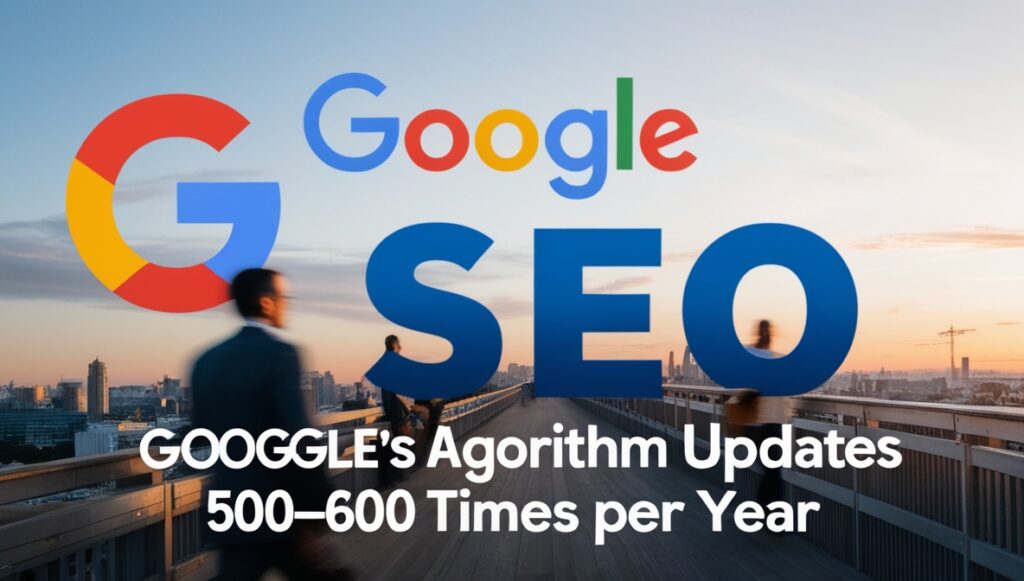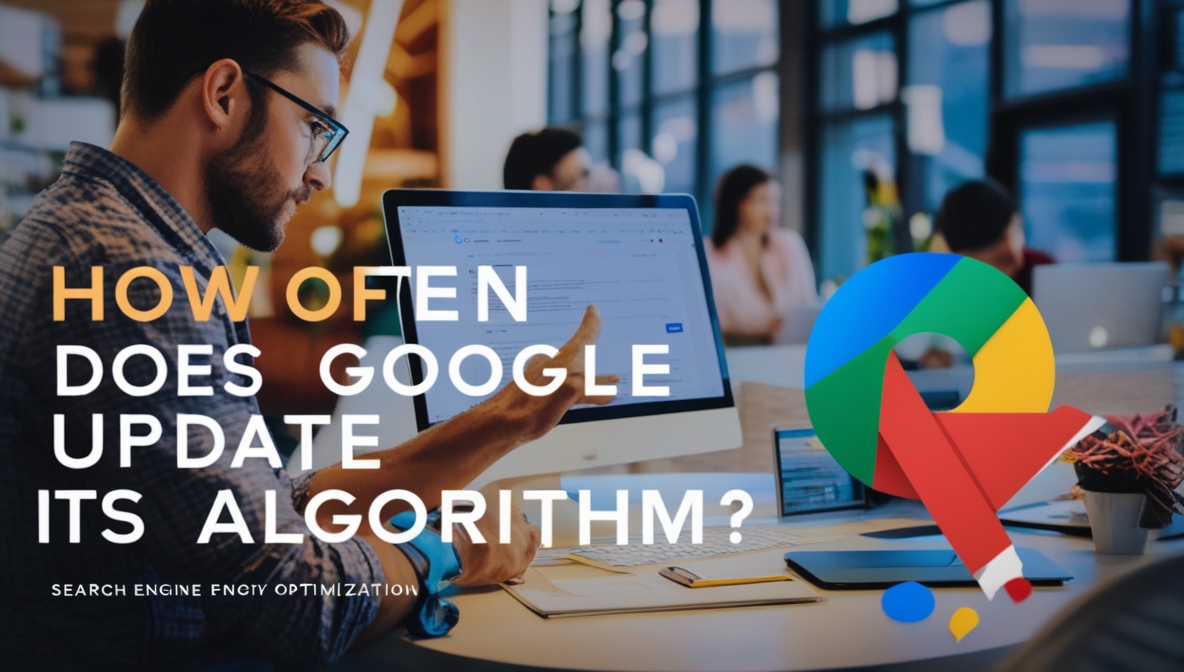
In the world of search engine optimization (SEO), keeping up with Google’s algorithm updates is essential for maintaining and improving your website’s search rankings. SEO professionals and business owners alike are constantly trying to understand how Google’s algorithm works, and how frequent updates can impact their digital marketing strategies. One common question that arises is: How often does Google update its algorithm?
Experts estimate that Google updates its algorithm somewhere between 500-600 times per year. Most of those changes are small and do not drastically impact rankings, while major updates, like BERT or Passage Ranking, can impact a significant percentage of all keyword searches. Understanding the frequency and nature of these updates is crucial for any digital marketing strategy, as it can directly affect how your website ranks on Google search results.
In this article, we will break down the Google update frequency, its impact on SEO, and how businesses and digital marketers can adapt their strategies to stay ahead of these changes.
What is a Google Algorithm Update?

To start, let’s first understand what a Google algorithm update actually is. Google’s search algorithm is a complex system that determines the relevance and ranking of web pages in response to a user’s search query. It takes into account hundreds of factors, including keywords, content quality, backlinks, site speed, and user experience, to provide the best results for each search.
When Google updates its algorithm, it adjusts how these factors are evaluated and how search results are ranked. Some updates focus on improving the relevance of search results, while others are designed to target and penalize spammy or low-quality content. These updates can be large and sweeping or minor and focused on refining existing ranking factors.
Google Update Frequency SEO: How Often Do Updates Happen?
Google’s algorithm updates are not limited to major events or scheduled launches; they happen frequently throughout the year. While Google does not always announce every update, it is widely recognized that the search giant makes somewhere between 500 and 600 updates annually. Most of these changes are small tweaks that do not drastically affect search rankings. These frequent minor updates are part of Google’s continuous effort to refine and improve its search results.
However, every so often, Google rolls out major updates that have a significant impact on the search landscape. These updates often target specific areas of SEO or aim to address broader changes in search behavior and technology. For instance, in recent years, Google’s introduction of algorithms like BERT (Bidirectional Encoder Representations from Transformers) and Passage Ranking has greatly altered how search queries are processed and ranked.
Let’s take a closer look at some of the major updates Google has rolled out in recent years:
Major Google Algorithm Updates
- Panda Update (2011): One of the first major updates to Google’s search algorithm, the Panda update was focused on penalizing websites with thin or low-quality content. Websites with spammy or duplicate content saw their rankings drop, while high-quality content was rewarded. This update pushed websites to prioritize content that was useful, original, and well-written.
- Penguin Update (2012): The Penguin update targeted websites that used manipulative link-building techniques, such as purchasing links or using link farms. Websites engaging in these black-hat SEO practices found themselves penalized in the rankings, while those focusing on natural link-building gained an advantage.
- Hummingbird Update (2013): Hummingbird was a significant update that introduced more natural language processing. This update allowed Google to better understand the meaning behind search queries rather than just matching keywords. This meant that websites needed to focus more on content relevancy and providing comprehensive answers to users’ questions.
- RankBrain Update (2015): RankBrain is a machine learning system that helps Google process search queries and rank results based on their relevance. This update was one of the first to incorporate artificial intelligence into Google’s ranking algorithm, making it better at interpreting user intent and providing relevant results for ambiguous or uncommon search queries.
- BERT Update (2019): The BERT update revolutionized how Google understands the nuances of language. It introduced deep learning techniques to interpret the context of words in a search query, helping Google to rank pages more effectively based on the user’s intent rather than just matching keywords.
- Passage Ranking (2020): Passage Ranking aimed to improve how Google ranks individual passages or sections of content within a page. This means that even if a page as a whole isn’t ranking well, specific passages that directly answer a query could now rank higher. This update placed even more emphasis on providing content that directly addresses user queries in a comprehensive manner.
How Google Update Frequency Affects Your SEO Strategy

With Google updating its algorithm hundreds of times per year, it’s clear that SEO is not a “set it and forget it” activity. The impact of frequent algorithm updates means that SEO professionals need to be proactive and stay informed. Below are some ways that Google’s update frequency affects SEO and what businesses can do to adapt.
1. Monitor Your Rankings Regularly
Because algorithm updates can cause fluctuations in search rankings, it’s essential to monitor your website’s performance regularly. Many SEO professionals use ranking tools to track their website’s position for targeted keywords and to spot any sudden drops or gains in rankings. Monitoring your rankings can help you quickly identify if an update has impacted your website.
2. Focus on High-Quality, Relevant Content
As we’ve seen with major updates like Panda and BERT, Google increasingly values high-quality, relevant content. Businesses should continuously audit their content strategy to ensure that they are creating content that answers user queries, addresses pain points, and is aligned with the latest search trends. Creating authoritative, comprehensive content will not only help you perform well with current algorithms but will also position your website for success as future updates are rolled out.
3. Optimize for User Experience (UX)
User experience (UX) has always been an important ranking factor, but Google’s algorithm updates, particularly those focused on mobile-first indexing and page experience, have made it even more critical. Websites that provide a positive user experience, including fast loading times, mobile optimization, and intuitive navigation, are more likely to rank well post-update. As Google’s algorithms continue to evolve, user experience will only become more important.
4. Stay Updated on Google’s Announcements
Google often announces major updates through its official blog or social media channels. Keeping up with these announcements will help you stay ahead of the curve and adjust your SEO strategy accordingly. Additionally, Google provides guidelines and best practices that can give you insight into what the company values most in search rankings.
5. Be Prepared for Algorithmic Penalties
Google’s algorithm updates are sometimes designed to penalize websites that violate its guidelines or use manipulative tactics. Websites that engage in black-hat SEO techniques, like keyword stuffing or buying backlinks, are at risk of being penalized when updates like Penguin are rolled out. It’s important to follow Google’s best practices and avoid shortcuts that could lead to long-term consequences.
Conclusion

The frequency of Google algorithm updates—estimated at 500-600 times per year—means that staying current with SEO best practices is more important than ever. While most of these updates are minor and don’t drastically change rankings, the occasional major update can have a significant impact on your website’s visibility. Understanding how Google’s algorithm evolves, and how frequent updates impact SEO, will help you adapt your strategy and maintain strong rankings in the competitive world of digital marketing.
For businesses in Hong Kong or anywhere else looking to improve their SEO performance, partnering with an experienced digital marketing agency like Dust Digital Marketing Ltd. can provide the expertise needed to navigate these constant changes. By staying on top of Google’s updates, investing in quality content, and optimizing for user experience, your business can remain competitive and visible in search results for years to come.

